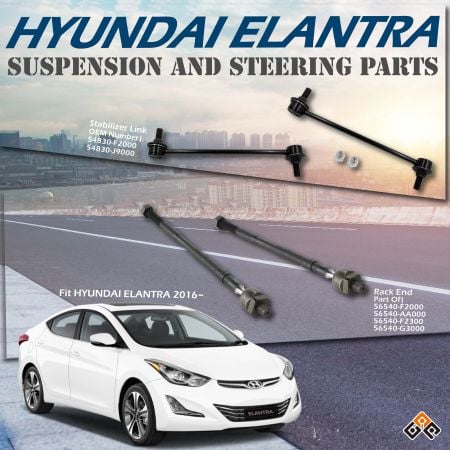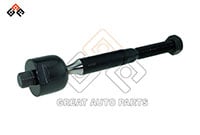How Navigating with Rack End Expertise your car's Stability by Idler Arm?
What is an Idler Arm
A robust assembly providing crucial support for the steering linkage that lies at the heart of your vehicle's steering mechanism lies the idler arm. Usually, an idler arm is connected on the opposite side of the center link from the pitman arm, securing the center link at the right height. This setup ensures it can accurately follow the movement of the pitman arm. Idler arms tend to wear out more often than pitman arms due to the pivoting mechanism they have.
Idler Arm vs. Pitman Arm: What's the Difference
| Feature | Idler Arm | Pitman Arm |
| Function | Supports the opposite end of the center | Converts rotational motion of the |
| Location | Mounted to the vehicle's frame or | Mounted on the steering box's output |
| Construction | Includes a pivoting mechanism with | Solid, robust piece of metal. Typically |
If you're interested in how your vehicle's steering system works, it's important to know the difference between the idler arm and the pitman arm. These two parts help your car steer correctly, but they do different jobs. Understanding their differences not only deepens your mechanical knowledge but also enhances your ability to diagnose and troubleshoot common steering issues effectively.
Idler Arm
The idler arm supports the opposite end of the center link from the pitman arm. It helps maintain the center link's proper height and alignment. Idler arm also acts as a pivoting support for the steering linkage, allowing it to move smoothly.
The idler arm is mounted to the vehicle’s frame or subframe. It mirrors the pitman arm’s movements on the other side of the vehicle, maintaining balance in the steering system.
Unlike the pitman arm, the idler arm often includes a pivoting mechanism with bushings. This design allows for slight movements and adjustments, which are necessary for smooth steering. While still sturdy, the idler arm incorporates flexible components that can wear out over time.
Pitman Arm
The pitman arm is directly linked to your vehicle's steering box. Its primary role is to convert the rotational motion of the steering wheel into the linear motion that turns the wheels.
It connects to the center link (also known as the drag link), which then links to the tie rods that steer the wheels. The pitman arm is mounted on the steering box's output shaft. When you turn the steering wheel, the steering box moves the pitman arm.
Typically, the pitman arm is a solid, robust piece of metal designed to withstand high levels of stress. It's often made from forged steel for strength and durability.
Why is the Idler Arm Important to Steering Components
The idler arm might seem like a small part, but its significance is monumental. It acts as a steadfast pivot, connecting various steering elements. When the idler arm functions optimally, it ensures that your steering wheel responds promptly and accurately. By acting as a pivot point, it allows the steering linkage to move smoothly and precisely, translating the driver’s inputs from the steering wheel to the wheels of the vehicle.
Connection of Idler Arm to the Vehicle Frame
The idler arm is securely attached to the vehicle’s frame or subframe, providing essential support and stability to the steering system. This connection allows the idler arm to mirror the movements of the pitman arm on the opposite side, maintaining balance and alignment within the steering linkage. The idler arm is mounted to a fixed bracket on the frame, keeping it firmly in place while allowing necessary pivoting for smooth steering.
How Does the Idler Arm Influence the Rack End
The idler arm significantly influences the rack end. Here is how:
Precise Alignment
The idler arm, as the steadfast pivot in the steering linkage, ensures the proper alignment of the rack end. When the idler arm is in optimal condition, it maintains the correct angle and position for the rack end. This alignment is crucial; it guarantees that the rack end functions smoothly.Balanced Force Distribution
The idler arm acts as a counterbalance to the force exerted by the pitman arm. This balance is essential to prevent undue stress on the rack end. When the idler arm functions seamlessly, it distributes the force evenly, preserving the integrity of the rack end.Mitigating Wear and Tear
A well-functioning idler arm ensures that the rack end experiences minimal wear and tear. By maintaining the correct alignment and distributing forces evenly, it reduces friction and stress on the rack end's components.Ensuring Responsive Steering
The idler arm's impact on the rack end directly influences your steering's responsiveness. A properly aligned and functioning idler arm guarantees that the rack end moves precisely as intended.
Customized Parts Services
Great Auto Parts specializes in providing custom automotive parts tailored to your specific needs. We offer a variety of custom parts, including unique steering components and specialized idler arm. Our experienced team collaborates with you to understand your requirements, designing and manufacturing each part to the highest quality standards. Whether you need a custom solution for a classic car restoration or a performance upgrade for modern vehicles, we deliver parts that meet and exceed your expectations. Partner with us for reliable, precision-engineered components that boost your vehicle's performance and durability.




